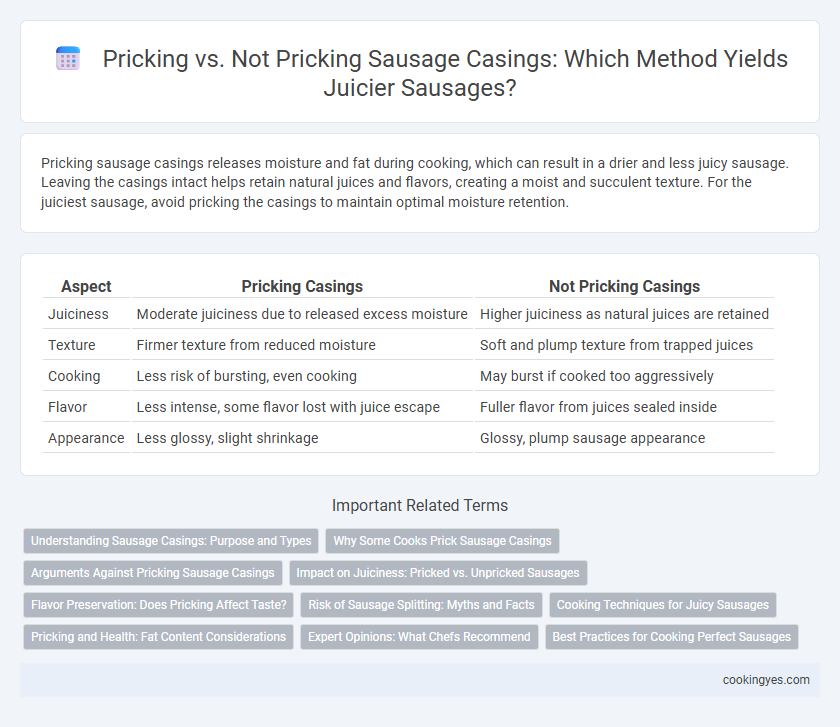Pricking sausage casings releases moisture and fat during cooking, which can result in a drier and less juicy sausage. Leaving the casings intact helps retain natural juices and flavors, creating a moist and succulent texture. For the juiciest sausage, avoid pricking the casings to maintain optimal moisture retention.
Table of Comparison
| Aspect | Pricking Casings | Not Pricking Casings |
|---|---|---|
| Juiciness | Moderate juiciness due to released excess moisture | Higher juiciness as natural juices are retained |
| Texture | Firmer texture from reduced moisture | Soft and plump texture from trapped juices |
| Cooking | Less risk of bursting, even cooking | May burst if cooked too aggressively |
| Flavor | Less intense, some flavor lost with juice escape | Fuller flavor from juices sealed inside |
| Appearance | Less glossy, slight shrinkage | Glossy, plump sausage appearance |
Understanding Sausage Casings: Purpose and Types
Pricking sausage casings allows steam to escape during cooking, preventing bursting and ensuring even cooking while maintaining juiciness. Natural casings, derived from intestines, are more prone to bursting and benefit from pricking, whereas synthetic casings like collagen or cellulose often do not require pricking due to their controlled permeability. Understanding the type of casing is essential for optimizing texture and juiciness in sausage preparation.
Why Some Cooks Prick Sausage Casings
Pricking sausage casings allows steam and excess fat to escape during cooking, preventing bursting and ensuring even heat penetration for a juicier texture. Some cooks prefer to prick casings to reduce the risk of sausage splitting, which helps maintain the meat's moisture and flavor. However, leaving casings intact can retain more juices, resulting in a richer, more succulent bite when done carefully.
Arguments Against Pricking Sausage Casings
Pricking sausage casings causes the loss of flavorful juices and fats during cooking, resulting in a drier, less succulent final product. Intact casings help retain moisture, enhancing the sausage's natural juiciness and improving texture. Sausage makers emphasize that preserving casing integrity ensures optimal taste and mouthfeel, making pricking unnecessary and detrimental to quality.
Impact on Juiciness: Pricked vs. Unpricked Sausages
Pricking sausage casings allows steam and fat to escape during cooking, resulting in a less juicy sausage as moisture is lost. Unpricked sausages retain internal juices more effectively, producing a firmer texture and richer flavor profile. Meat processors and chefs often prefer unpricked casings to maximize juiciness and enhance the eating experience.
Flavor Preservation: Does Pricking Affect Taste?
Pricking sausage casings can lead to the loss of essential juices, resulting in a drier texture and diminished flavor intensity. Leaving casings unpricked helps retain moisture, preserving the sausage's rich, juicy taste and enhancing overall flavor depth. Maintaining intact casings ensures the sausages remain succulent and flavorful during cooking.
Risk of Sausage Splitting: Myths and Facts
Pricking sausage casings is often believed to prevent sausages from splitting, but studies show it can actually cause juices to escape, resulting in drier sausage. Sausage splitting primarily results from improper casing filling or excessive heat, not the absence of pricking. Maintaining correct filling pressure and cooking temperature are key factors to achieve juicy, intact sausages.
Cooking Techniques for Juicy Sausages
Pricking casings before cooking sausages allows steam to escape, preventing casing rupture and ensuring even cooking, but can cause juices to leak, resulting in a drier sausage. Leaving casings intact helps retain the natural juices, preserving moisture and enhancing flavor, especially when cooking over moderate heat or grilling. Optimal cooking techniques balance heat control and casing integrity to achieve succulent, juicy sausages without compromise.
Pricking and Health: Fat Content Considerations
Pricking sausage casings allows excess fat and moisture to escape during cooking, reducing the overall fat content and promoting a leaner, healthier sausage. However, skipping pricking helps retain natural juices and fat, enhancing flavor and tenderness but increasing calorie and fat intake. Balancing pricking techniques with fat content considerations supports healthier sausage preparation without compromising taste.
Expert Opinions: What Chefs Recommend
Expert chefs widely recommend avoiding pricking sausage casings to retain maximum juiciness, as piercing causes the natural juices to escape during cooking. Culinary authorities emphasize that intact casings help maintain the sausage's moisture and enhance flavor consistency. Some experts note that slight scoring is acceptable only for very thick sausages to ensure even cooking without significant juice loss.
Best Practices for Cooking Perfect Sausages
Pricking sausage casings allows steam to escape, preventing bursting and ensuring even cooking, but it may cause loss of flavorful juices, resulting in a drier sausage. Cooking sausages without pricking preserves juiciness by retaining natural fats and moisture, making it ideal for grilling or pan-frying over gentle heat. For perfect sausages, use low to medium heat and avoid piercing casings to maintain tenderness and flavor.
Pricking casings vs not pricking for juicy sausage Infographic

 cookingyes.com
cookingyes.com